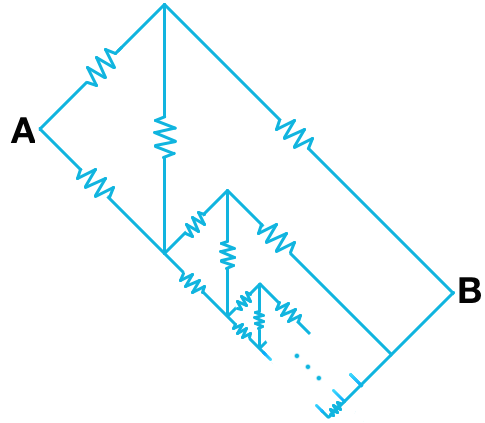My What A Lot Of Resistors You Have

Find the equivalent resistance between points A and B , given that each resistance is 1 Ω and the pattern continues with the same arrangement until the 1 7 6 th vertically oriented resistor, as shown in the image.
The answer is 1.
This section requires Javascript.
You are seeing this because something didn't load right. We suggest you, (a) try
refreshing the page, (b) enabling javascript if it is disabled on your browser and,
finally, (c)
loading the
non-javascript version of this page
. We're sorry about the hassle.
1 solution
Very good explanation, loved it.
Here is my answer to the challenge: If the bottom-right corner of the five-resistor diamond is R , then the equivalent resistor of that diamond is R ′ = 3 R + 5 5 R + 3 , R ′ − 1 = 3 ( R − 1 ) + 8 2 ( R − 1 ) . By repeating the circuit as shown in this problem, this calculation is repeated over and over. This will cause R to get ever closer to 1.
Start with the last part of the circuit: the "diamond" of four 1-ohm resistors with a fifth resistor as a bridge.
Because the circuit is symmetric, that bridging resistor is not doing anything: the points it connects have equal potentials, so that there is no current flowing through it.
That simplifies the circuit to the diamond, which is a parallel circuit of two branches of 2 ohms each.
The equivalent resistance of the last part is therefore half of 2 ohm, that is, 1 ohm.
Now this equivalent resistance is the bottom-right corner of the next part of the circuit, which once again is a diamond with a bridge. What we see is that each next part up in the circuit is identical to the previous part; every time the overall resistance is 1 ohm.
After 176 steps, we still have an equivalent resistance of 1 ohm.
Challenge: What if the bottom-right resistor of the last part is not 1 ohm, but R ohms?